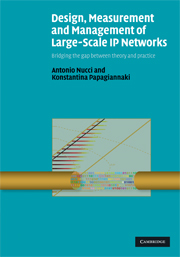 Design, Measurement and Management of Large-Scale IP Networks
Design, Measurement and Management of Large-Scale IP Networks from III - From bits to services
Published online by Cambridge University Press: 05 September 2012
Open, any-to-any connectivity is clearly one of the fundamentally great properties of the Internet. Unfortunately, the openness of the Internet also enables an expanding and everevolving array of malicious activity. During the early 1990s, when malicious attacks first emerged on the Internet, only a few systems at a time were typically compromised, and those systems were rarely used to continue or broaden the attack activity. At first, the attackers were seemingly motivated simply by the sport of it all. But then, as would seem to be the natural order of things, the miscreants were seized by the profit motive. Today, network infrastructure and end systems are constantly attacked with an increased level of sophistication and virulence.
In this chapter, we discuss and face two of the most dangerous threats known by the Internet community: Denial of Service (DoS) and computer worms. In the following we refer to them simply by DoS and Computer Worms. Those two families of threats have different goals, forms and effects than most of the attacks that are launched at networks and computers. Most attackers involved in cyber-crime seek to break into a system, extract its secrets, or fool it into providing a service without the approprite authorization. Attackers commonly try to steal credit card numbers or proprietary information, gain control of machines to install their software or save their data, deface Web pages, or alter important content on victim machines.
To save this book to your Kindle, first ensure [email protected] is added to your Approved Personal Document E-mail List under your Personal Document Settings on the Manage Your Content and Devices page of your Amazon account. Then enter the ‘name’ part of your Kindle email address below. Find out more about saving to your Kindle.
Note you can select to save to either the @free.kindle.com or @kindle.com variations. ‘@free.kindle.com’ emails are free but can only be saved to your device when it is connected to wi-fi. ‘@kindle.com’ emails can be delivered even when you are not connected to wi-fi, but note that service fees apply.
Find out more about the Kindle Personal Document Service.
To save content items to your account, please confirm that you agree to abide by our usage policies. If this is the first time you use this feature, you will be asked to authorise Cambridge Core to connect with your account. Find out more about saving content to Dropbox.
To save content items to your account, please confirm that you agree to abide by our usage policies. If this is the first time you use this feature, you will be asked to authorise Cambridge Core to connect with your account. Find out more about saving content to Google Drive.